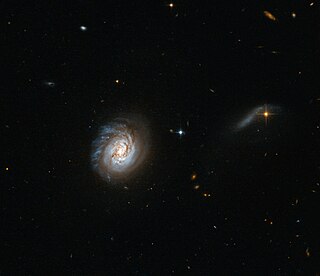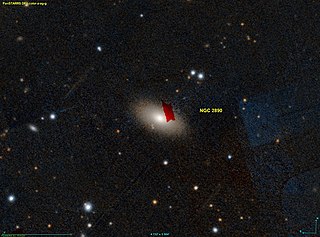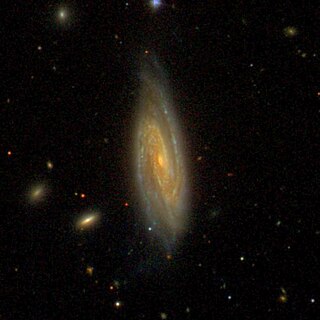
NGC 1559 is a barred spiral galaxy in the constellation Reticulum. It was discovered on 6 November 1826 by Scottish astronomer James Dunlop.

NGC 7479 is a barred spiral galaxy about 105 million light-years away in the constellation Pegasus. William Herschel discovered it in 1784. NGC 7479 is also recognized as a Seyfert galaxy and a LINER undergoing starburst activity not only on the nucleus and the outer arms, but also across the bar of the galaxy, where most of the stars were formed in the last 100 million years. Polarization studies of this galaxy indicate that it recently underwent a minor merger and that it is unique in the radio continuum, with arms opening in a direction opposite to the optical arms. This feature, along with the asymmetrical arms of the galaxy and the intense star formation activity are attributed to a merger with a smaller galaxy. This galaxy is similar in both size and morphology to the barred spiral NGC 1300.

NGC 5033 is an inclined spiral galaxy located in the constellation Canes Venatici. Distance estimates vary from between 38 and 60 million light years from the Milky Way. The galaxy has a very bright nucleus and a relatively faint disk. Significant warping is visible in the southern half of the disk. The galaxy's relatively large angular size and relatively high surface brightness make it an object that can be viewed and imaged by amateur astronomers. The galaxy's location relatively near Earth and its active galactic nucleus make it a commonly studied object for professional astronomers.

NGC 4639 is a barred spiral galaxy located in the equatorial constellation of Virgo. It was discovered by German-born astronomer William Herschel on April 12, 1784. John L. E. Dreyer described it as "pretty bright, small, extended, mottled but not resolved, 12th magnitude star 1 arcmin to southeast". This is a relatively nearby galaxy, lying approximately 72 million light-years away from the Milky Way. It is a companion to NGC 4654, and the two appear to have interacted roughly 500 million years ago. NGC 4639 is a member of the Virgo Cluster.

NGC 1672 is a barred spiral galaxy located in the constellation Dorado. It was discovered by the astronomer James Dunlop on November 5, 1826. It was originally unclear whether it was a member of the Dorado Group, with some sources finding it to be a member and other sources rejecting its membership. However, recent tip of the red-giant branch (TRGB) measurements indicate that NGC 1672 is located at the same distance as other members, suggesting it is indeed a member of the Dorado Group.

NGC 1084 is an unbarred spiral galaxy in the constellation Eridanus. It is located at a distance of about 63 million light-years away from the Milky Way. The galaxy was discovered by William Herschel on 10 January 1785. It has multiple spiral arms, which are not well defined. It belongs in the same galaxy group with NGC 988, NGC 991, NGC 1022, NGC 1035, NGC 1042, NGC 1047, NGC 1052 and NGC 1110. This group is in turn associated with the Messier 77 group.

NGC 4699 is an intermediate spiral galaxy located in the constellation Virgo. It is located at a distance of about 65 million light years from Earth, which, given its apparent dimensions, means that NGC 4699 is about 85,000 light years across. It was discovered by William Herschel in 1786. It is a member of the NGC 4699 Group of galaxies, which is a member of the Virgo II Groups, a series of galaxies and galaxy clusters strung out from the southern edge of the Virgo Supercluster.

NGC 3147 is a spiral galaxy located in the constellation Draco. It is located at a distance of about 130 million light years from Earth, which, given its apparent dimensions, means that NGC 3147 is about 140,000 light years across. It was discovered by William Herschel on April 3, 1785.

NGC 4939 is a spiral galaxy located in the constellation Virgo. It is located at a distance of about 120 million light years from Earth, which, given its apparent dimensions, means that NGC 4939 is about 190,000 light years across. It was discovered by William Herschel on March 25, 1786.

NGC 6951 is a barred spiral galaxy located in the constellation Cepheus. It is located at a distance of about 75 million light-years from Earth, which, given its apparent dimensions, means that NGC 6951 is about 100,000 light-years across. It was discovered by Jérôme Eugène Coggia in 1877 and independently by Lewis Swift in 1878.

NGC 3393 is a barred spiral galaxy located in the constellation Hydra. It is located at a distance of circa 180 million light-years from Earth, which, given its apparent dimensions, means that NGC 3393 is about 140,000 light-years across. It was discovered by John Herschel on March 24, 1835. It is a Type II Seyfert galaxy, known to host two supermassive black holes, which are the nearest known pair of supermassive black holes to Earth.

MCG -03-04-014 or PGC 4167, is a spiral galaxy located 450 million light-years in the constellation of Cetus. MCG -03-04-014 is classified as a luminous infrared galaxy, meaning it has high star-formation regions. MCG -03-04-014 has a galactic center that is obscured by dust lanes and presents an abundant supply of molecular gas. The reasons behind the luminosity of this galaxy are debated among astronomers. Some attribute it to recent starbursts, while others point to activity in the galaxies' supermassive black holes. It is also considered that both factors may contribute. The exact cause remains uncertain.

NGC 2890 is a lenticular galaxy in the constellation of Hydra. Its velocity with respect to the cosmic microwave background is 5455 ± 37 km/s, which corresponds to a Hubble distance of 80.45 ± 5.67 Mpc. It was discovered by American astronomer Francis Leavenworth on 11 January 1886.

NGC 7808 is an lenticular galaxy in the constellation of Cetus. Its velocity with respect to the cosmic microwave background is 8521 ± 24 km/s, which corresponds to a Hubble distance of 125.67 ± 8.80 Mpc. It was discovered by American astronomer Frank Muller in 1886.

NGC 5875 is an spiral galaxy in the constellation of Boötes. Its velocity with respect to the cosmic microwave background is 3585 ± 6 km/s, which corresponds to a Hubble distance of 52.87 ± 3.70 Mpc. It was discovered by German-British astronomer William Herschel on 1 May 1788.

NGC 2642 is a barred spiral galaxy in the constellation of Hydra. Its velocity with respect to the cosmic microwave background is 4632 ± 21 km/s, which corresponds to a Hubble distance of 68.32 ± 4.79 Mpc. It was discovered by British astronomer John Herschel on 19 February 1830.

NGC 958 is a barred spiral galaxy in the constellation of Cetus. Its velocity with respect to the cosmic microwave background is 5505 ± 17 km/s, which corresponds to a Hubble distance of 81.20 ± 5.69 Mpc. However, 19 non-redshift measurements give a distance of 58.93 ± 12.91 Mpc. The galaxy was discovered by German-British astronomer William Herschel on 20 September 1784.

NGC 4375 is a barred spiral galaxy in the constellation of Coma Berenices. Its velocity with respect to the cosmic microwave background is 9325 ± 20 km/s, which corresponds to a Hubble distance of 137.54 ± 9.63 Mpc. However, four non-redshift measurements give a distance of 105.5 Mpc. The galaxy was discovered by German-British astronomer William Herschel on 11 April 1785.

NGC 3052 is a intermediate spiral galaxy in the constellation of Hydra. Its velocity with respect to the cosmic microwave background is 4122 ± 24 km/s, which corresponds to a Hubble distance of 60.79 ± 4.27 Mpc. However, 19 non redshift measurements give a distance of 42.563 ± 6.434 Mpc. The galaxy was discovered by German-British astronomer William Herschel on 7 February 1785.

NGC 3362 is a intermediate spiral galaxy in the constellation of Leo. Its velocity with respect to the cosmic microwave background is 8676 ± 25 km/s, which corresponds to a Hubble distance of 127.97 ± 8.97 Mpc. However, three non redshift measurements give a distance of 95.8 ± 3.984 Mpc. The galaxy was discovered by German astronomer Albert Marth on 22 March 1865.




















